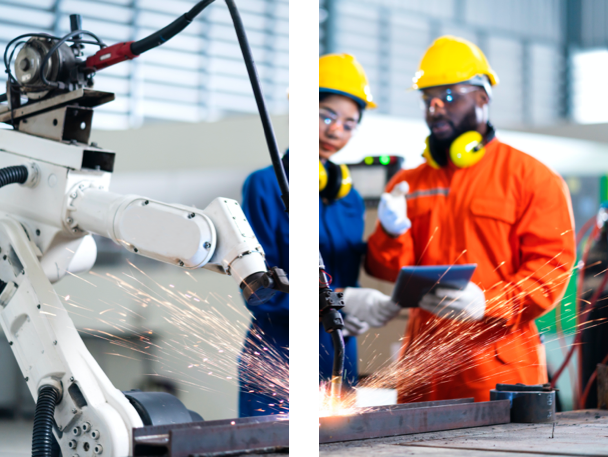Prediction of machinery maintenance needs
Automated quality inspection
Single data management among all the agents involved.
Automation of administrative processes
Detection of anomalies in the production line
Improved remote work capabilities of line personnel
Reduction of technician training times
Leverage organizational knowledge
Automated control of working conditions
Simulation of manufacturing and prototyping conditions
Monitoring and control of construction machinery
Optimization of planning and inventories
Business Intelligence
& Data Analytics
Artificial
intelligence
Extended
Realities
Robotic
Process Automation
IoT
Digital
Twins

Data analysis and business intelligence.|
Data strategy in the industrial sector.|
.| The industrial sector generates huge amounts of data at every node of the value chain.
.| It is essential that this data flows and converges between all participating agents to ensure transparency and process optimization.
.| The incorporation of Internet of Things (IoT) technology has generated additional needs in terms of infrastructure and data management.
.| The exploitation of data provides an enormous capacity for optimization at many levels of the chain.
To discover the knowledge hidden in the data, from any source.
Do it in a collaborative way among all participating agents.
Enable the organization to make decisions efficiently.
Employ AI capabilities to access data visualizations in an intuitive manner
Reduce complex reporting and solution development times

Industries
Industrial Vision Solution.|
Machine vision solution that provides automatic image-based inspection and analysis for applications such as automatic inspection, process control, robot guidance, etc.
Vision Solution for the industrial sector.|
Thanks to Machine Learning and Deep Learning algorithms it is possible to analyze visual images and extract information to be able to make subsequent decisions. These algorithms can be executed in the Cloud or on the devices themselves, depending on the needs of the company.
Through images, algorithms, and processing devices we obtain valuable information for decision-making.
Increases employee productivity. Thanks to this solution, processes that used to require human supervision can be automated.
Cost optimization because the quality of products can be improved, focusing employees on other different tasks.
Guaranteed safety, since we will be able to detect any desired object to prevent accidents.
Immediate presentation of validation results, without delays in the production chain.
Improved quality thanks to algorithms that will allow us to verify the assemblies in a chain to detect problems before they happen, among others.
Speed and automatic learning, the algorithms used are automatically improved as they are used.
Continuous real-time data collection
Build predictive models/learning algorithms
Real-time data analysis to detect failures and root cause patterns
Sending alerts/notifications to take action
Improve equipment maintenance plan
Optimize spare parts inventories and costs
Predictive maintenance of production equipment with AI .|
.I Production equipment in any factory, as well as auxiliary equipment for transport, and material movement, among others, provide, through sensorization, a large volume of data on their operation.
.I I Prediction of deadlines for possible failure events or the proximity to the life limit of each component, thus being able to improve equipment maintenance plans and optimize spare parts purchase cycles and associated inventories.
.I I Reduction of equipment downtime, thus optimizing the production of each piece of equipment and, in general, of the entire factory.

Mixed Reality and its tools.|
Microsoft Dynamics 365 Remote Assist
Microsoft Dynamics 365 Remote Assist enables technicians to collaborate and troubleshoot with remote collaborators using Dynamics 365 Remote Assist for mobile devices or Microsoft Teams.
Microsoft Dynamics 365 Guides
Microsoft Dynamics 365 Guides is a mixed reality tool that enables employees to learn through interactive instructions.
Increases employee productivity by up to 25% through the use of available tools.
Improved training and preparation for complex tasks that require several steps to execute.
Ensures quality by offering a better service and with a much better-trained staff.
Optimization of direct costs by up to 15%, thanks to remote assistance and employee training.
The first step many companies take to begin implementing their Factory of the Future is to connect their equipment (production assets) for complete visibility.
Remote monitoring allows companies to continuously monitor the health and performance of individual assets, as well as entire factories to predict potential problems and manage changing customer demand in the industrial sector.

Production and supply chain .I
.| Environmental conditions incidence analysis
.| Simulation of production impact of equipment failure
.| Production balancing between lines
.| Optimization of stock levels in the face of demand variations
.| Identification of bottlenecks in production lines.
.| Definition of production buffers
Criticality assessment
Definition of the progressive digitalization plan
Cost assessment
Detailed definition of the process
Evaluation of the expected return
Development of the digitization process
Connection with IoT systems
Training of AI and ML models
Deployment and testing
Putting into production
Continuous improvement

